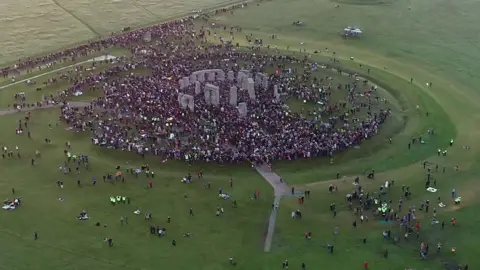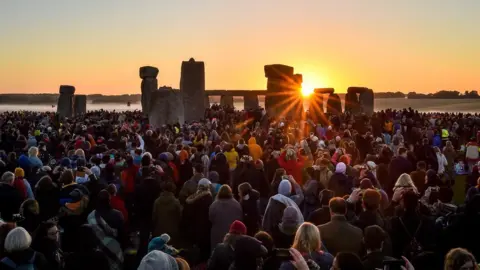Stonehenge summer solstice event cancelled for a second year
 BBC
BBCThe summer solstice gathering at Stonehenge has been cancelled for a second year following a decision to extend Covid-19 lockdown measures.
Traditionally about 10,000 revellers gather at the Wiltshire monument, on or around 21 June, to mark midsummer.
English Heritage said numbers were "far in excess of the 4,000 permitted at outdoor gatherings" and it had made the "difficult decision" to cancel.
Senior druid King Arthur Pendragon posted that he intended to "be there".
The sunrise and sunset will again be live-streamed on English Heritage's social media.
 PA Media
PA MediaEnglish Heritage cancelled both last year's summer and winter solstice celebrations due to the pandemic.
Stonehenge director Nichola Tasker said she shared "people's disappointment with this decision".
"We were busy getting ready to welcome everyone for summer solstice but the announcement this week left us with no choice," she said.
"We're working with the pagan and druid community to ensure that small groups can still mark in person what is a very important moment for them."
 Getty Images
Getty ImagesKing Arthur Pendragon posted on his Facebook page that he would still be at the Neolithic site.
"Just as spring, autumn, winter of 2020 and the spring equinox this year - it is my intention to be as close to the Heel Stone as possible," he said.
"And as on previous occasions it is not my intention to break the law - but be there I shall on one side of the fence or another."
The summer solstice is one of the rare occasions that English Heritage normally opens up the stones for public access.
On the summer solstice, the sun rises behind the Heel Stone, the ancient entrance to the Stone Circle, and rays of sunlight are channelled into the centre of the monument.
English Heritage said it had consulted with Wiltshire Council and the police, among others, before making the decision.

What is the summer solstice?
- The term 'solstice' derives from the Latin word 'solstitium', meaning 'sun standing still'.
- For northern hemisphere dwellers, the 2020 summer solstice occurs on 20 June at 22:43 BST.
- Stonehenge is a monument that aligns to the midsummer sunrise and the midwinter sunset.
- On the summer solstice, the central Altar stone at Stonehenge aligns with the Heel stone, the Slaughter stone and the rising sun to the north east.
- Sunrise is celebrated at Stonehenge on 21 June as it is the nearest sunrise to the summer solstice at 22:43 BST on 20 June.
